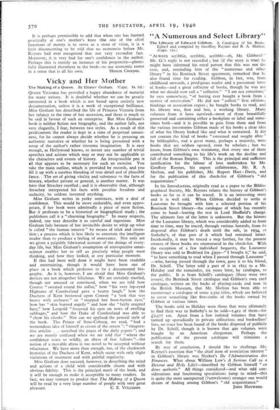"A Numerous and Select Library"
The Library of Edward Gibbon. A Catalogue of his Books. Editei and compiled by Geoffrey Keynes and R. A. Skelton. (Cape. 15s.)
" ALWAYS scribble, scribble, scribble—eh, Mr. Gibbon? " Mr. G.'s reply is not recorded ; but (if the story is true) he might have informed his royal patron that this was not the case, and, reminding him of the " numerous and select library " in his Bentinck Street apartment, remarked that he also found time for reading. Gibbon, in fact, was, from childhood onwards, a prodigious reader and a passionate lover of books—and a great collector of books, though he was not what we should now call a " collector." " I am not conscious," he says somewhere, " of having ever bought a book from a motive of ostentation." He did not " collect " first editions, bindings or association copies ; he bought books to read, and his library was, first and last, a working library. Many volumes from it have survived—most of them beautifully preserved and containing either a bookplate or label and some- times both—and it is possible to gain from them and from the various inventories Gibbon made of his books a clear idea of what his library looked like and what it contained. It did not contain the kind of books " esteemed and sought after " by bibliophiles, and a great many, perhaps a majority, were books that are seldom opened, even by scholars ; but we know, from Gibbon's own testimony, that every one of them contributed something to his life's work on the decline and fall of the Roman Empire. This is the principal and sufficient justification for the labour of love undertaken by Mr. Geoffrey Keynes, his expert collaborator, Mr. R. A. Skelton, and his publisher, Mr. Rupert Hart - Davis, and for the publication of this check-list of Gibbon's " old acquaintance."
In his Introduction, originally read as a paper to the Biblio- graphical Society, Mr. Keynes relates the history of Gibbon's books so far as it can be traced. It is an interesting story and it is well told. When Gibbon decided to settle at Lausanne he brought with him a selected portion of his Bentinck Street library—the catalogue of which has recently come to hand—leaving the rest in Lord Sheffield's charge. The ultimate fate of the latter is unknown. But the history of the Lausanne library, which was considerably added to from time to time, may be traced, through various hazards, from its dispersal after Gibbon's death until the sale, in 1934, St Sotheby's, of that part of it which had remained intact. Incidentally, it may be traced a step further, for the present owners of these books are enumerated in the check-list. With the exception of a few individual bequests, the Lausanne library was sold to Beckford for L950—" I bought it," he said, " to have something to read when I passed through Lausanne " —who, having passed through the town, gave it to his friend, Dr. Scholl. The latter sold a part of it in 1825 to a Mr. Haliday and the remainder, six years later, by catalogue, to the public. It is from Scholl's catalogues (there were two issues), the Bentinck Street catalogue and Gibbon's own card catalogue, written on the backs of playing-cards and now in the British Museum, that Mr. Skelton has been able to reconstruct a catalogue of some 2,500 titles, which are believed to cover something like five-sixths of the books owned by Gibbon at various times.
The books sold to Haliday were those that were ultimately to find their way to Sotheby's to be sold-4412 of them—for £1,577 Jos. Apart from a few isolated volumes that have turned up sporadically in private collections and booksellers' lists, no trace has been found of the books disposed of publicly by Dr. Scholl, though it is known that 400 volumes were bought by an American clergyman. Perhaps the publication of the present catalogue will stimulate a search for them.
By way of conclusion, I should like to challenge Mr. Keynes's assertion that " the chief item of association interest " in Gibbon's library was Necker's De !'Administration des Finances. What about William Law's -A Serious Call to a Devout and Holy Life?—inscribed by Gibbon himself " ex dono author's." All things considered—and what odd con- siderations and fascinating speculations jump to mind—this is quite the most unexpected (?unwelcome) stranger one would dream of finding among Gibbon's " old acquaintance."
JoRN HAYWARD.










































 Previous page
Previous page